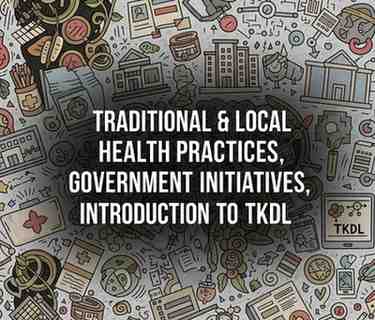
Your Account
Designed by Zeptt Technologies

Traditional and Local Health Practices (TLHPs) are time-tested indigenous methods used by local communities for maintaining health and managing diseases.
These practices are often holistic, community-based, eco-friendly, and utilize locally available herbs and materials.
They are passed orally through generations and often lack formal documentation.
TLHPs include home remedies, folklore medicine, bone-setting techniques, midwifery, ethno-veterinary practices, and use of kitchen pharmacy.
🔸 "Swasthasya swasthya rakshanam, Aturasya vikara prashamanam cha" — आ.हृ. सूत्रस्थानम् 1/20
(Translation: The objective of Ayurveda is to maintain the health of the healthy and treat the disease of the sick.)
TYPES OF TRADITIONAL & LOCAL HEALTH PRACTICES
Household Remedies: Usage of turmeric, ginger, pepper, honey, etc., for common cold, fever, indigestion.
Folk Healing Systems: Traditional bone setters, herbalists, and spiritual healers.
Ethno-Medicine: Local tribal healthcare knowledge using forest produce like Ashwagandha, Guduchi, Haritaki, etc.
Midwifery and Traditional Birthing Practices: Local dais providing prenatal and postnatal care.
Community-based Practices: Use of Dhupa, Lepa, Kavala, Gandusha, Agnihotra, etc., to maintain local hygiene and immunity.
🔸 "Lokanām hita kāmyaya, vyākhyātāḥ śāstrāṇi sāttvikaiḥ" — च. सूत्रस्थानम् 30/26
(Translation: The noble sciences are explained by the wise for the welfare of people.)
SIGNIFICANCE OF TRADITIONAL & LOCAL HEALTH PRACTICES IN RASASHASTRA & BHAISHAJYA KALPANA
Many formulations in Rasashastra have their roots in traditional practices.
Use of Bhasma, Pishti, Avaleha, Arka, Lepa, Taila, and Ghrita are adapted from traditional formulations.
Local knowledge about Shodhana (purification) and Marana (incineration) has guided the classical processes.
Local methods of Bhaishajya Kalpana like decoctions (Kashaya), infusions (Phanta), and medicated oils have informed classical texts.
🔸 "Dravyam gunaḥ karma chaiva trividham karma samhitam" — च. सूत्रस्थानम् 1/26
(Translation: Every drug has three essential features – substance, property, and action.)
MODERN VIEW ON TRADITIONAL & LOCAL HEALTH PRACTICES
Recognized as Complementary and Alternative Medicine (CAM) globally.
Increasing validation through clinical studies, ethnobotany, and pharmacognosy.
Documented in Ethnopharmacological surveys and WHO Traditional Medicine Strategy.
Part of Ayurveda Pharmacopoeia and Ayush Quality Standards.
Widely used in Community Health Programs and Primary Health Centers in rural India.
GOVERNMENT INITIATIVES TO PRESERVE TRADITIONAL & LOCAL HEALTH PRACTICES
National AYUSH Mission (NAM): Promotes Ayurveda, Yoga, Unani, Siddha, and Homeopathy systems.
AYUSH Health & Wellness Centres: Integration of AYUSH with public health infrastructure.
Scheme for Promotion of Local Health Traditions (LHT): Documentation and promotion of local health knowledge.
National Institute of Indian Medical Heritage (NIIMH): Digitization of classical and folk manuscripts.
Support to Traditional Healers: Skill development, certification, and inclusion in national healthcare.
AYUSH GRIDS and e-AUSHADHI Portal: For integration of AYUSH and modern healthcare systems.
Documentation under NMPB: National Medicinal Plants Board supports surveys and conservation.
BRIEF INTRODUCTION TO TRADITIONAL KNOWLEDGE DIGITAL LIBRARY (TKDL)
TKDL is a digital library that systematically documents and translates traditional medical knowledge (like Ayurveda, Siddha, Unani, Yoga) in multiple international languages.
Launched by CSIR in collaboration with Ministry of AYUSH to prevent biopiracy and protect Intellectual Property Rights (IPR).
Helps patent examiners globally to verify the novelty of claims related to traditional knowledge.
TKDL covers classical texts such as Charaka Samhita, Sushruta Samhita, Bhavaprakasha, and Yogaratnakara.
Aims to bridge the gap between ancient wisdom and modern intellectual property mechanisms.
🔸 "Yat pinde tat brahmande" — क. संहिता, खीलस्थानम्
(Translation: That which exists in the body exists in the universe — reflecting the universal application of traditional wisdom.)
MODERN RASASHASTRA & BHAISHAJYA KALPANA PERSPECTIVE
Inclusion of Standardization Techniques like TLC, HPTLC, AAS, and ICP-MS to validate local formulations.
Importance of Pharmacovigilance in identifying adverse effects of folk remedies.
Integration of GMP (Good Manufacturing Practices) in processing classical and local drugs.
Awareness regarding Drug-Drug Interactions with modern medications.
Promotion of Herbo-mineral combinations in tribal and rural therapeutics.